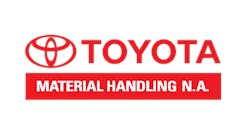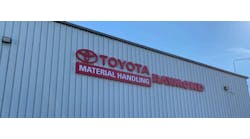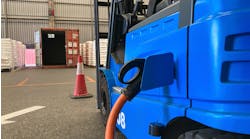Few companies escaped the path of the economic whirlwind last year, and manufacturers of lift trucks were no exception. Although trends are moving in the right direction now, it will take time for bruised business to bounce back.
That explains why “cautious optimism” is the phrase repeated by most lift truck industry leaders, who understand that “up” is relative, and the journey out of the abyss is going to take time.
Statistics from the Industrial Truck Association (ITA) are telling. “In 2009, the market was off almost 40% from 2008 and 55% down from its peak in 2006,” says Jeff Rufener, president of ITA and vice president of marketing at Mitsubishi Caterpillar Forklift America (MCFA). “Over time, the industry has sustained growth, but it’s been a wild ride.”
Rufener says the first quarter of 2010 was stronger than ITA expected. “We have seen the bottom, and we are recovering,” he notes, “although we are recovering from a very low level.” According to the most recent ITA quarterly survey, full-year 2010 numbers are expected to be 10% to 15% higher than 2009’s figures.
“The global nature of the slowing economy affected every aspect of our business,” says Jonathan Dawley, vice president of marketing at NACCO Materials Handling Group Inc. (NMHG), manufacturer of the Hyster and Yale lift truck brands. “No lift truck manufacturer was spared impact as the customer base eliminated capital programs and sidelined large segments of their fleets.”
Chuck Pascarelli, president of sales and marketing for the Raymond Corp., agrees. “The lift truck market in calendar year 2009 was the lowest that we’ve experienced since the early 1980s,” he says. However, “the market has been in an ‘up’ trend so far this year. Rental utilizations and parts sales are increasing, which are always good precursors to an increase in truck sales; we remain cautiously optimistic.”
Brett Wood, president of Toyota Material Handling USA Inc. (TMHU), uses the same language when presenting his outlook. “We have cautious optimism for the remainder of the year,” he says. “The current market conditions are more optimistic, as the market is up approximately 30% compared to the same period in 2009 (January through April). Customer quote activity is strong, and pent-up demand has contributed to these favorable results in the first part of 2010.”
NMHG, too, is “cautiously optimistic that global market levels for units and parts volumes will improve at a moderate pace,” says Al Rankin Jr., chairman, president and CEO of parent company NACCO Industries Inc. “However, NMHG is not anticipating a market upturn of significance compared with the levels for the most recent six months, until the second half of 2010, with the exception of China and Brazil.” In North America, Rankin expects “moderate growth over the next three quarters.”
Exceeding Expectations
Caution aside, lift truck manufacturers continue to revise their 2010 predictions upward. While the latest material handling equipment manufacturing forecast released by the Material Handling Industry of America (MHIA) places growth in new orders at 6% to 9.5%, lift truck manufacturers are topping that.
“Although we won’t return to the peak levels of 2006 for some time, we are seeing growth that could top MHIA’s expectations,” Wood explains. “It’s been an encouraging first quarter.”
Raymond’s Pascarelli echoes that sentiment. “Our original projections were for modest growth similar to what MHIA forecasted,” he says, “but we are now seeing more robust trends and have increased our growth projections for the lift truck market to approximately 20%.”
Jim Moran, senior vice president at Crown Equipment, also says demand has been better than anticipated. “The market demand for the first four months of the year is tracking ahead of where many of us thought it would be,” Moran says. “We forecasted an 8% to 10% increase in demand compared to the same time period last year. We’re seeing demand track 44% ahead of last year in the electric forklift market and at an even higher growth pace for IC [internal combustion] forklifts.”
While Moran observes continued growth in IC lift trucks, Rufener has a different view. “The mix continues to be strongly oriented toward electric,” he says. “We’ve seen this trend in the past, but now, it’s more pronounced with the focus on energy costs and ecology. As the economy recovers, there will be a rebound in IC, but there’s staying power in electric.”
TMHU’s Wood agrees. “Electric forklift sales have remained a key area for expansion in North America, in part because of their applications in the food and beverage industries and growing environmental concerns and regulations for lower-emission equipment,” Wood says. “In 2009, electrics represented 67% of all lift truck sales. This is a 7% increase over 2008.”
Bo Maslanyk, national sales director at Clark Material Handling Co., also believes demand for electric lift trucks will grow and, like others, forecasts growth in all lift truck segments to be “slightly higher” than MHIA’s projections.
Fleet Analysis
So, where, specifically, is the growth? According to Dawley, the food and logistics industries were stronger than most other markets during the downturn. “As a result, the industry saw a significant rise in the percentage of Class III units booked,” he says.
“Moving into 2010, we have now seen signs of recovery in other segments. The industry is seeing a flattening out of the mix to include more Class I, IV and V units, which shows that the supply chain as a whole is coming back online.”
However, Dawley notes that durable goods manufacturing continues to lag, even as gross domestic product and consumer sentiment rise. “Once the raw materials begin to be produced for the durable goods industry, we should continue to see a shift toward the traditional counterbalance products,” he says. “The market in general is expected to have a significant amount of pent-up demand, which is leading economists to predict exceptionally strong industry volumes in the coming years.”
This pent-up demand will lead to new equipment purchases, according to lift truck manufacturers. “For more than a year, many businesses have decided to postpone lift truck purchases,” explains Wood. “They’ve extended their lift truck lease or the time between purchases by holding on to older trucks a little longer. However, this practice can only continue for so long before all of the lift trucks in a fleet require maintenance or servicing.”
And that’s when new investment starts to make sense. “The older a lift truck, typically the more maintenance that needs to be performed,” Wood says. “Eventually, this becomes a more expensive proposition than replacing the older fleet with newer lift trucks that require less maintenance.”
“There will be significant strain on aged fleets if underutilized,” adds Rufener. “Increasing capacity will cause these aging fleets to start to fail. If users are managing assets effectively, they will see that it becomes cheaper to buy new than to repair existing equipment.”
Clark’s Maslanyk also believes new investment will be necessary as the overall economy improves. “Many customers held off replacing fleets during the recession and made do with existing fleets,” he says. “Actually, customers’ fleets were, in many cases, only partially utilized as production was scaled down. This means that equipment replacement should take place over the next couple of years as production increases.”
Lift truck companies also say more material handling professionals are analyzing their investments more closely. “Customers are looking beyond purchase price to see the true cost of ownership,” says Wood. “They need to see the value of their purchase. This means looking at productivity levels, run times, lift speeds, safety features, downtime, estimated maintenance costs and more.”
“Customers desire to track not only product cost of ownership, but also the productivity of their operators and equipment,” adds Maslanyk.
And closer scrutiny often requires better technology. Rufener says lift truck buyers are interested in a variety of fleet management strategies, ranging from basic hour-meter readings to fully integrated asset management systems. He also says some operations are turning fleet management over to third parties to tap into more advanced asset management capabilities.
Pascarelli from Raymond says many of his customers are looking at operator statistics. “Facility managers are looking to better understand the work habits of their employees, such as the amount of time they travel with a load versus travel without a load, and how many impacts the operators have during a particular period of time,” he explains.
Maintenance is another key factor in managing fleets. “Preventative maintenance completion is on the rise as equipment is coming back into service,” observes Dawley. “Customers will likely not be purchasing equipment due to amount of usage but rather due to time considerations. With a high percentage of equipment being leased in the industry, customers are driven to transition equipment on a specific timeline. This timeline can be stretched but must be managed.”
Additionally, lift truck users are “looking for methods to extend the lifecycle and improve utilization of their existing fleets,” says Crown’s Moran. “Because of this, most companies want to understand at a much deeper level how they are spending maintenance dollars. This has triggered increased investment in fleet optimization products.”
Still, “advanced technology is a luxury,” Wood says, “and over the last two years, companies have been forced to focus on the basics of managing their fleet by maintaining existing lift trucks and replacing only when needed. As the market recovers, we hope to see companies invest more in these worthwhile technologies.”
High-Tech Trucks
Interest in emerging technologies, such as fuel cells, may have declined due to the recession, but lift truck manufacturers are certain of the potential. “The recession certainly dampened how aggressively customers were going after fuel cell programs,” says Dawley. “We are, however, seeing strong interest in fuel cells as the economy is coming back. Customers are interested in the ability of fuel cells to deliver productivity enhancements and low cost of operations.”
“Customers are very interested in new technologies,” adds Pascarelli. “However, the recession put many capital expenditures on hold. Greenfield projects offer the best value proposition to warehouse operators who want to deploy hydrogen fuel cells. However, the recession has certainly slowed the pace of new warehouse construction, making new technology adoption slower than it might have been in a more robust economic environment.”
But Moran from Crown doesn’t believe interest in fuel cells has waned. “There has been no dampening of interest in fuel cell technology; rather, this interest has gained momentum,” he says. “There is no question in my mind that the lift truck market is the best opportunity for the fuel cell industry to go to full commercialization.”
Differences aside, all lift truck experts agree that a turnaround is on the way. Whether future growth comes from implementation of advanced technologies or simple replacement of aging fleets, lift trucks seem to be reaching in the right direction.


